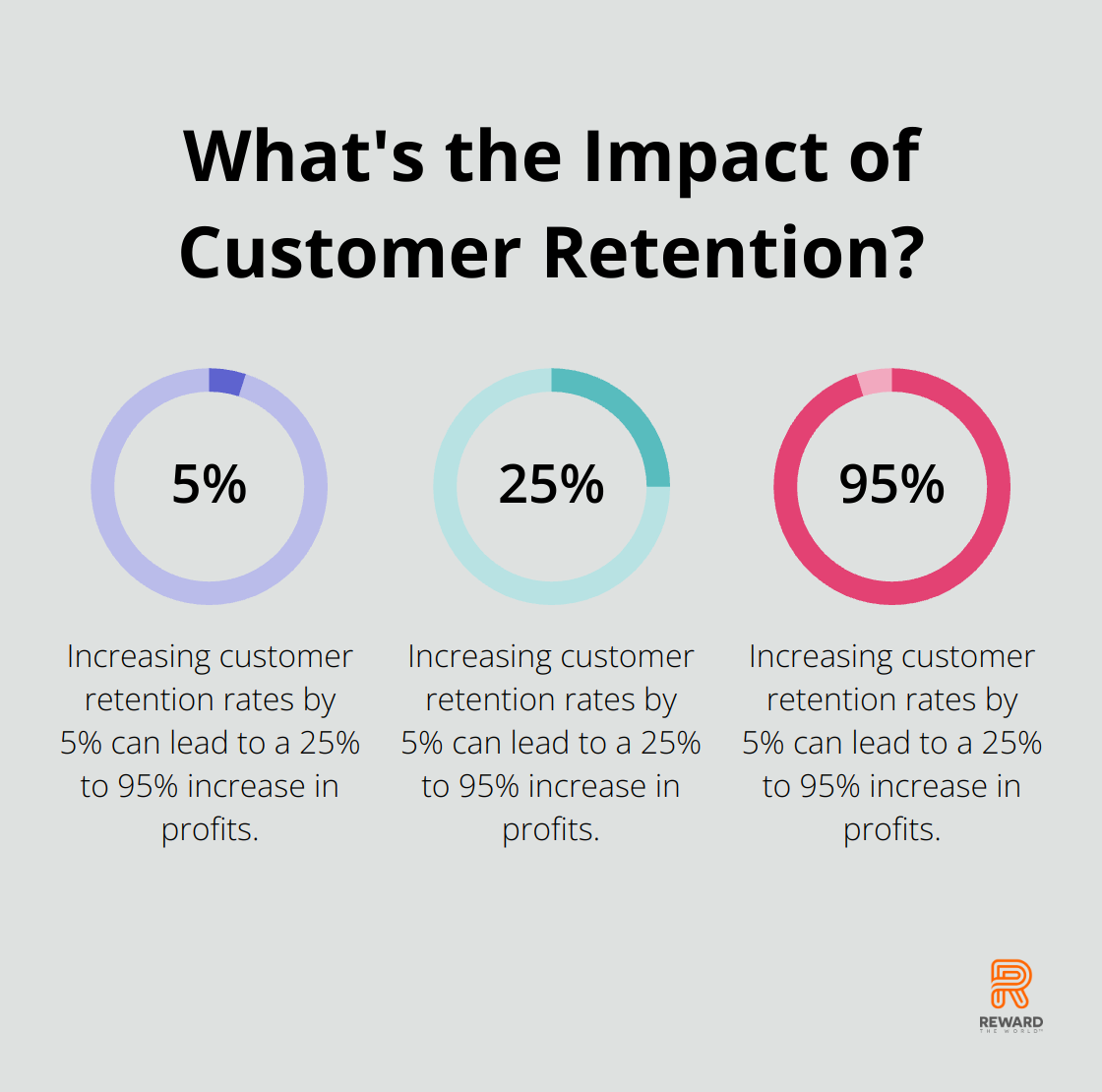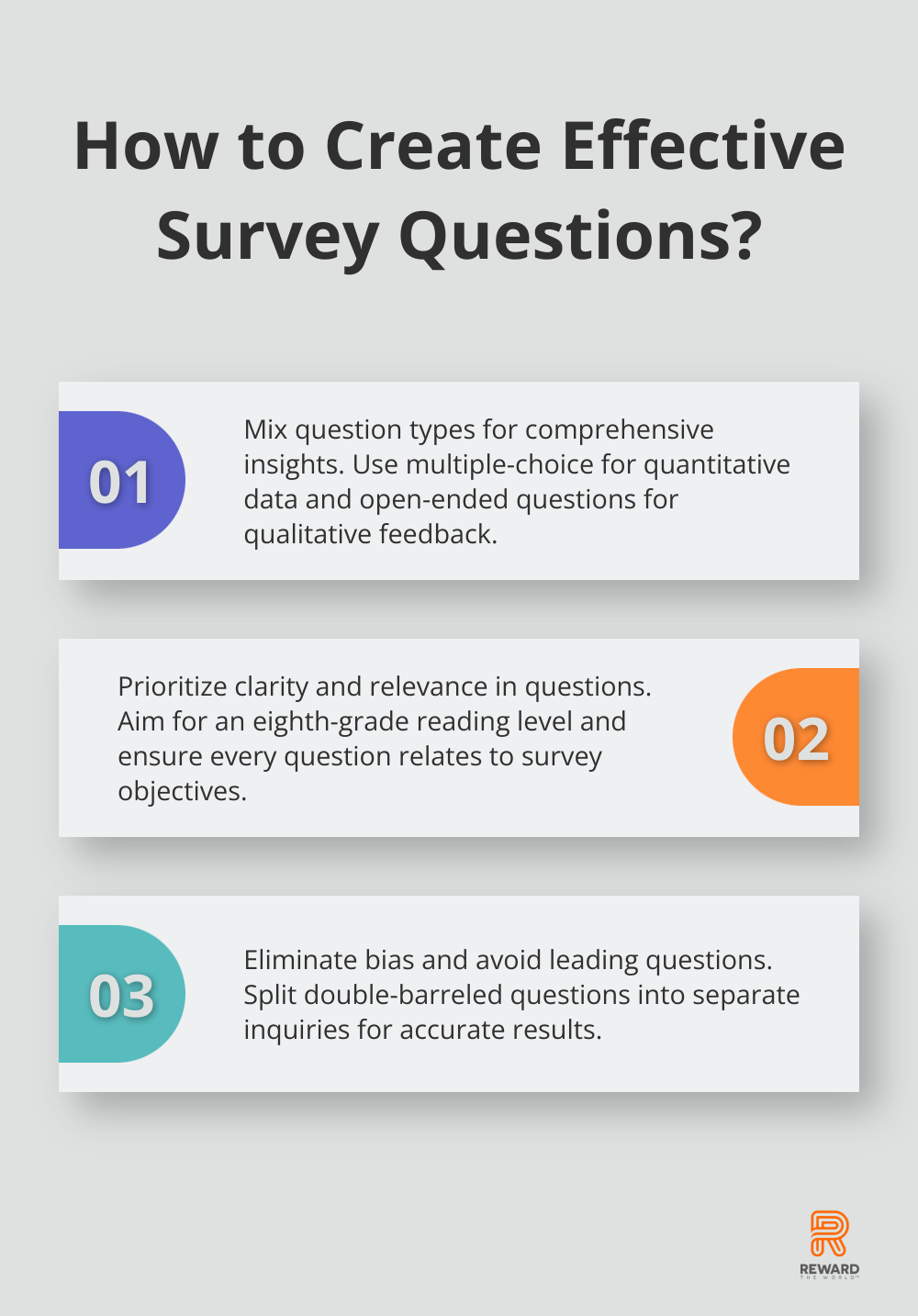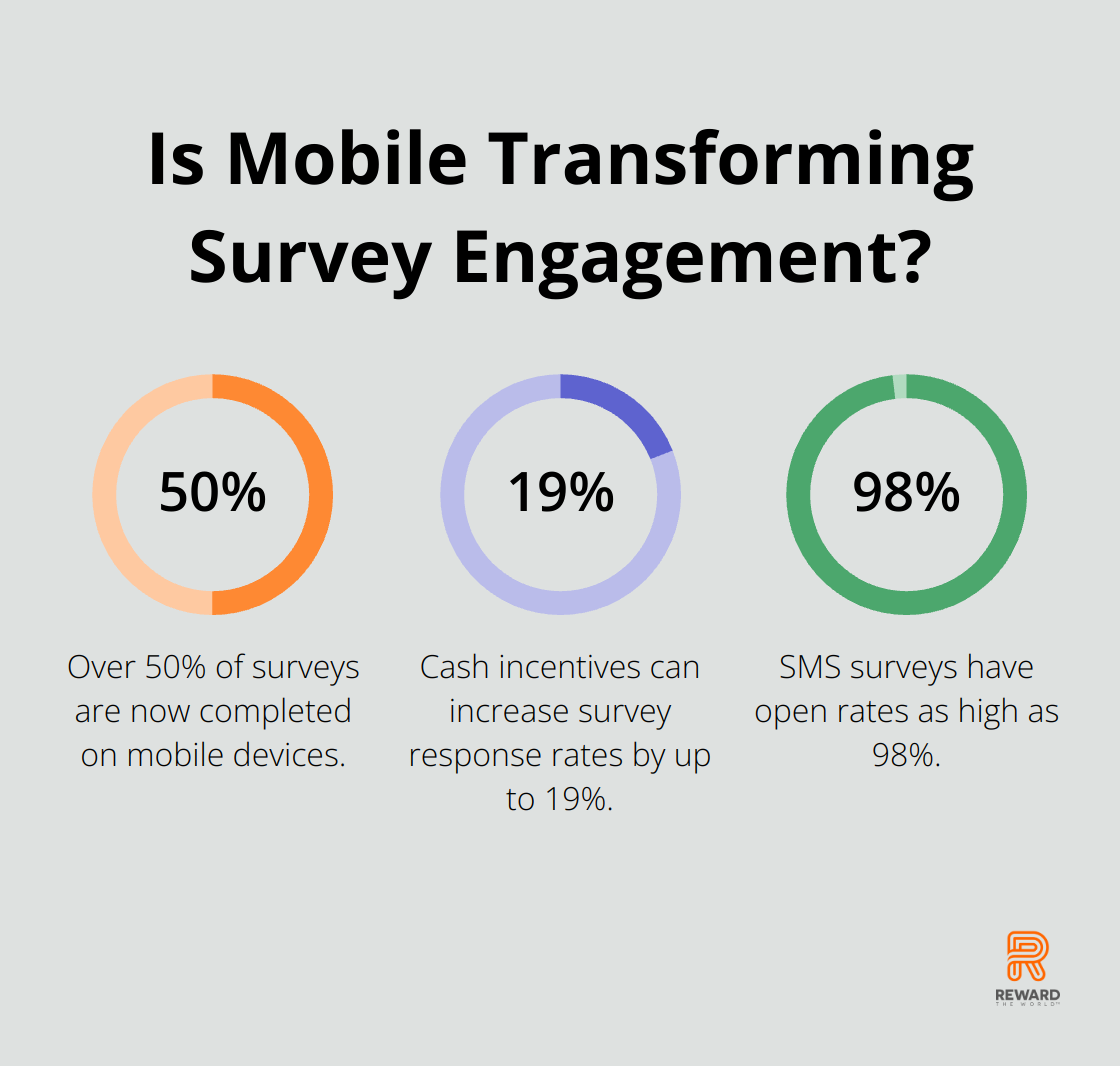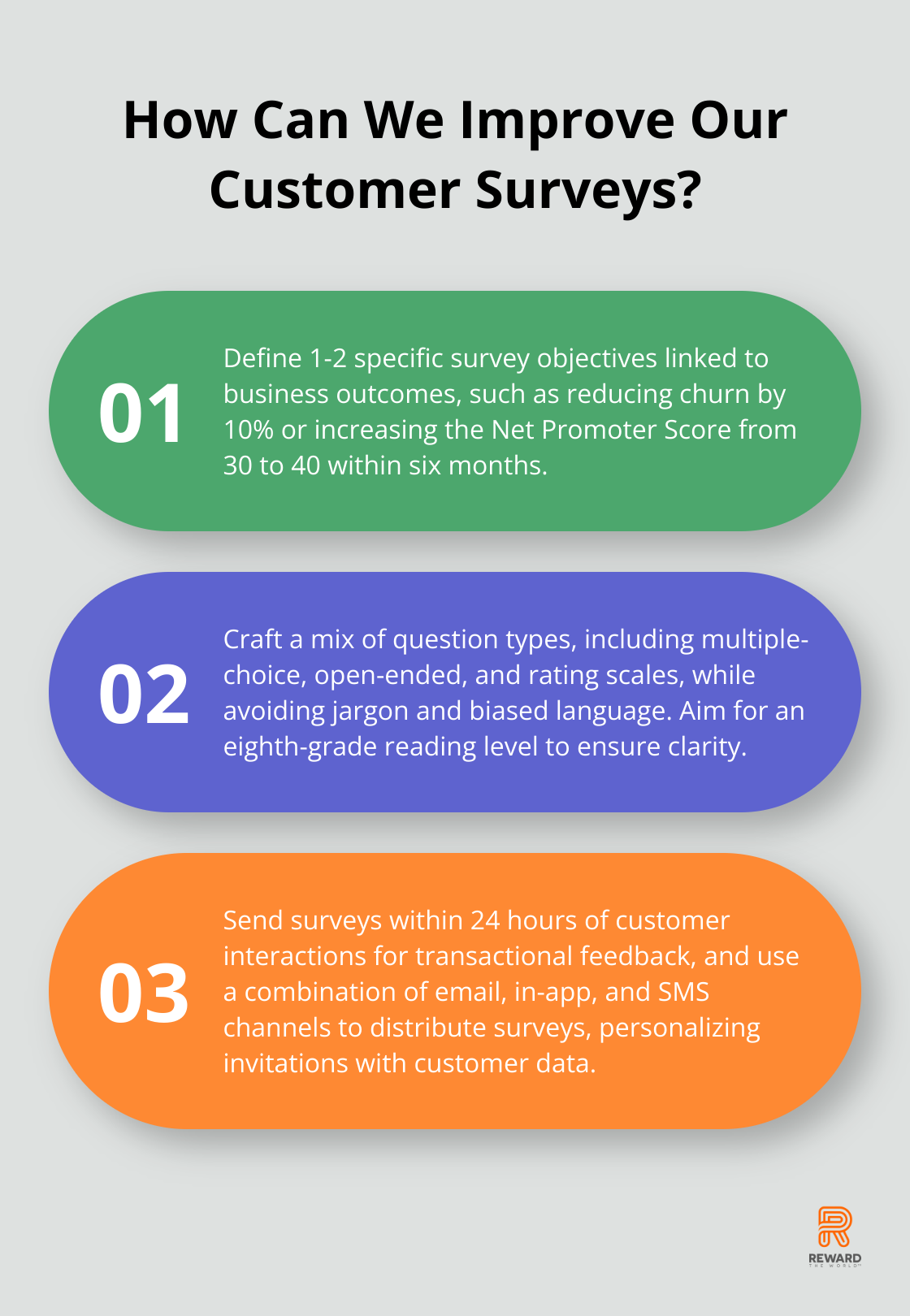
Customer loyalty surveys are powerful tools for understanding and improving customer satisfaction. At Reward the World, we’ve seen firsthand how well-crafted surveys can transform businesses.
But creating effective surveys isn’t as simple as asking a few questions. It requires careful planning, thoughtful design, and strategic implementation to yield valuable insights.
Define Your Survey Objectives
Pinpoint Your Survey’s Purpose
Start by asking yourself: What do you want to learn from your customers? Do you want to gauge overall satisfaction, identify at-risk customers, or understand what drives loyalty in your industry? For example, a hotel chain might want to know why guests choose their properties over competitors. Be specific and limit yourself to one or two primary goals per survey to maintain focus.
Link Objectives to Business Outcomes
Your survey goals should directly support your broader business strategy. If your company aims to reduce churn by 10% this year, your survey should help identify factors that contribute to customer attrition. Research shows that increasing customer retention rates by just 5% can lead to a 25% to 95% increase in profits. With such high stakes, it’s essential to align survey objectives with business goals.
Choose the Right Loyalty Metrics
Selecting appropriate metrics is key to measure customer loyalty effectively. The Net Promoter Score (NPS) is a widely used metric, but it shouldn’t be your only focus. Try to incorporate the Customer Effort Score (CES) to measure ease of doing business with you, or the Customer Satisfaction Score (CSAT) for specific interactions.

A McKinsey report found that in the United States, companies that are leaders of CX achieved more than double the revenue growth of “CX laggards”. We recommend using a combination of metrics to get a comprehensive view of customer loyalty.
Tailor Objectives to Your Industry
Different industries have unique customer loyalty dynamics. For example, a subscription-based software company might focus on user engagement and feature adoption, while a retail brand might prioritize repeat purchase behavior and average order value. Customize your survey objectives to address the specific loyalty challenges and opportunities in your sector.
Set Measurable Goals
Transform your objectives into measurable goals. Instead of a vague aim like “improve customer satisfaction,” set a specific target such as “increase our NPS score from 30 to 40 within six months.” This approach allows you to track progress and adjust your strategies as needed.
With clear, well-defined objectives in place, you’re ready to move on to the next critical step: designing effective survey questions that will yield the insights you need to achieve your goals.
How to Craft Compelling Survey Questions
Mix Question Types for Comprehensive Insights
At Reward the World, we recommend using a variety of question types to capture different aspects of customer loyalty. Multiple-choice questions provide quantitative data, while open-ended questions allow customers to express their thoughts freely. For example:

Multiple-choice: How often do you use our product?
- Daily
- Weekly
- Monthly
- Rarely
- Never
Open-ended: What’s the main reason you choose our product over competitors?
Rating scales measure satisfaction levels effectively. For instance:
On a scale of 1-5, how satisfied are you with our customer support?
Prioritize Clarity and Relevance
Clear, concise questions lead to accurate responses. Avoid jargon and complex language. Try to aim for an eighth-grade reading level. For example, instead of asking, “To what extent does our product fulfill your requirements?” simply ask, “Does our product meet your needs?”
Relevance matters equally. Every question should directly relate to your survey objectives. Irrelevant questions can cause survey fatigue and lower completion rates.
Eliminate Bias in Your Questions
Biased questions can skew your results and lead to inaccurate conclusions. Avoid leading questions that suggest a preferred answer. For instance, instead of asking, “How much did you enjoy our excellent customer service?” ask, “How would you rate our customer service?”
Double-barreled questions (which ask about two issues in one question) should also be avoided. For example, don’t ask, “How satisfied are you with our product quality and pricing?” Instead, split this into two separate questions.
Incorporate the Net Promoter Score
The Net Promoter Score (NPS) measures how many more people are likely to strongly recommend your site or product compared to those who are not. Include the standard NPS question: “On a scale of 0-10, how likely are you to recommend our product/service to a friend or colleague?”
Don’t stop there. Follow up with an open-ended question asking why they gave that score. This combination provides both quantitative data and qualitative insights.
The key to effective survey questions lies in balance. Try to use a mix of question types, keep them clear and relevant, avoid bias, and always include the NPS question. With these principles in mind, you’ll create surveys that yield valuable, actionable insights for your business. Now, let’s explore how to implement best practices for survey distribution to maximize response rates and gather meaningful data.
How to Maximize Survey Response Rates
Time Your Surveys Strategically
The timing of your survey can significantly impact response rates. A study by SurveyMonkey reveals that surveys sent on Monday, Friday, or Saturday tend to have the highest response rates. However, this can vary depending on your industry and audience.

For transactional surveys, send them within 24 hours of the interaction. This ensures the experience remains fresh in the customer’s mind. For relationship surveys, consider quarterly or bi-annual distribution to track changes over time without overwhelming your customers.
Select Appropriate Distribution Channels
Your choice of distribution channel should align with your customers’ preferences. Email remains a popular option, with an average response rate of 30% (according to Genroe). However, in-app surveys can yield even higher engagement, especially for software products.
SMS surveys are gaining traction, with open rates as high as 98%. They prove particularly effective for quick, one-question surveys. Try using a mix of channels to reach different segments of your audience.
Personalize Your Survey Invitations
Personalized survey invitations can increase response rates significantly. Use your customer data to tailor the invitation. Address the recipient by name, reference their recent interactions with your brand, and explain why their feedback matters.
For example: “Hi John, we noticed you recently purchased our new XYZ product. We’d love to hear your thoughts to help us improve our offerings.”
Offer Smart Incentives
Offering incentives can boost response rates, but it’s important to choose the right type. Cash incentives can increase survey response rates by up to 19%. However, they may also attract low-quality responses from people only interested in the reward.
Non-monetary incentives, such as entry into a prize draw or loyalty points, can be equally effective and often more cost-efficient. Reward the World’s platform offers a range of incentives, from eGift cards to charitable donations, tailored to audience preferences.
Optimize Survey Length and Design
Keep your surveys concise and visually appealing. Research shows that shorter surveys (5-10 minutes) typically achieve higher completion rates. Use progress bars to show respondents how far they’ve come, and ensure your survey is mobile-friendly (as over 50% of surveys are now completed on mobile devices).
Mix up question types and keep them short and to the point. Use visual breaks to make the survey easy on the eyes and incorporate a variety of question formats to maintain engagement.
Final Thoughts
Customer loyalty surveys transform businesses when designed and implemented effectively. Clear objectives, compelling questions, and best distribution practices yield invaluable insights into customer needs, preferences, and pain points. These surveys improve customer retention, identify areas for enhancement, spot potential churn risks, and reveal loyalty drivers in specific industries.

We urge you to implement customer loyalty surveys in your business strategy now. Collect feedback regularly, analyze the results, and act on the insights you gather. Your customers will appreciate being heard, and you’ll make data-driven decisions that enhance their experience and strengthen their loyalty.
For businesses aiming to streamline their survey process and maximize engagement, Reward the World’s incentives platform offers a comprehensive solution. With its user base, multilingual support, and diverse reward options (including eGift cards), it can boost survey participation rates and help you gather more meaningful data.
